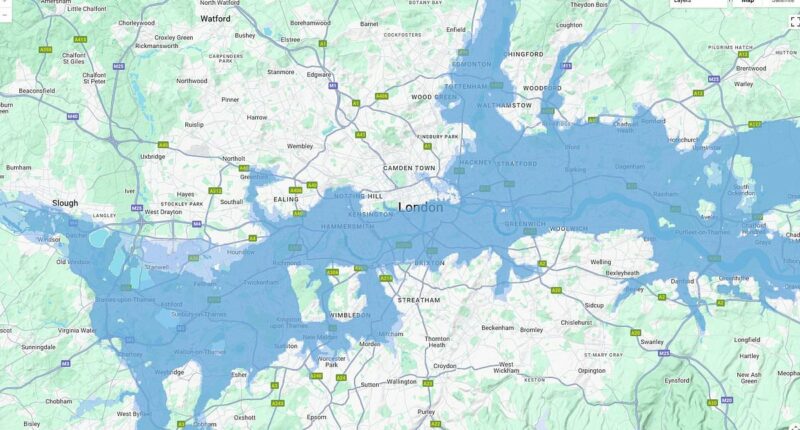Share this @internewscast.com
Rising sea levels could plunge more than 100 million buildings underwater by 2100, scientists have warned.
Experts in Canada have evaluated the potential flooding impact on buildings in Africa, Southeast Asia, and Central and South America due to varying sea level increases.
Their assessment found that sea level rises of just 1.6 feet (0.5 metres) would flood three million buildings in the global south alone.
If emissions are not reduced soon, sea levels could soar over 16 feet (five meters) in the next century, endangering up to one-sixth of all structures in the global south.
Worryingly, the researchers at McGill University in Montreal say that much of this destruction is now practically unavoidable.
Even if the objectives of the Paris Agreement are achieved, it is expected that sea level rises of nearly three feet (0.9 meters) will flood five million buildings by the century’s end.
Professor Natalya Gomez, a co-author of the study, explains: ‘Sea level rise is a gradual yet unavoidable outcome of global warming that is already affecting coastal communities and will persist for hundreds of years.’
‘There is often discourse about sea levels rising by mere centimeters or maybe a meter, but the reality is it could rise by many meters if we don’t promptly halt fossil fuel usage.’

Scientists have utilized satellite maps to estimate the number of buildings at risk of being destroyed with sea level rises ranging from 0.5 meters (indicated in red) to 20 meters (indicated in yellow). In the most severe scenario, over 100 million buildings could be submerged in the global south alone.
The researchers focused their analysis on the Global South – the bottom half of the world comprising Africa, Southeast Asia and Central and South America – but they’ve created a map showing what flooding would look like worldwide.
In their first large-scale, building-by-building assessment of its kind, the researchers combined high-resolution satellite information and elevation data.
Using this, they were able to estimate how many buildings would be inundated under various sea level scenarios, from increases of 1.6 feet (0.5 metres) up to 65 feet (20 metres).
As the climate warms, sea levels rise due to the melting of polar ice sheets and glaciers, as well as the fact that water in the oceans expands as it heats up.
Scientists currently believe that 1.6 feet of sea level rise will occur even if governments around the world take rapid measures to cut greenhouse gas emissions.
When this occurs, the researchers predict that millions of buildings will be permanently plunged underwater, with many more placed within the high tide mark.
The researchers’ flooding map shows that large parts of UK coastal towns, such as Great Yarmouth, will be permanently underwater, while massive areas of cities like London will be beneath the high tide mark.
In London, tidal flooding will extend as far as Peckham in the south and Barking in the north.

If immediate action is taken to curb emissions, sea levels will rise by just 1.6 feet (0.5 metres). However, this will already put large parts of London under the high tide mark

Under the best-case scenario of 1.6 feet (0.5 metres) of sea level rise, entire towns in the Northeast could be submerged during high tide

Even if the world makes good on its commitments under the Paris Agreement to reach net-zero by 2050, studies predict sea levels will still rise by three feet (0.9 metres) by 2100. This will put large areas of London underwater. Pictured: artist’s impression of London underwater
Co-author Professor Jeff Cardile says: ‘We were surprised at the large number of buildings at risk from relatively modest long-term sea level rise.
Even if the world makes good on its commitments under the Paris Agreement to reach net-zero by 2050, studies predict sea levels will still rise by three feet (0.9 metres) by 2100 and by 8.5 feet (2.5 metres) by 2300.
That means a further five million buildings are expected to be below the high tide mark by the end of the century, increasing to 20 million by 2030.
However, scientists predict that global sea levels could rise by as much as 16 feet (five metres) to 65 feet (20 metres) if the world doesn’t reach net zero soon.
If the sea level becomes 16 feet higher, the researchers estimate that 45 million buildings in Africa, Southeast Asia and Central and South America alone will be flooded.
That number rises to a staggering 136 million buildings if sea levels are allowed to rise by 65 feet.
In this absolute worst-case scenario, entire regions of the UK would be completely swallowed by the waves.
Cambridge, Peterborough, York, Hull, and even Doncaster would be permanently underwater.

In the worst-case scenario, large parts of England, and almost the entirety of the Netherlands, will be permanently underwater

Many of the towns worst affected by flooding will be extremely densely populated areas like Natal, Brazil. The disruption caused by the flooding will damage global food networks as ports are submerged
Meanwhile, large parts of major towns and cities such as Liverpool, Cardiff, Bristol, Glasgow and London would be submerged while high tides would reach the outskirts of Manchester and Leeds.
Globally, the effects would be disastrous, especially for poorer countries with less ability to mitigate or adapt to the effects of flooding.
An estimated 30 per cent of the global population lives within 31 miles (50 km) of the coast, and 20 of the 26 largest megacities are located on the coast.
Additionally, many of the areas this study predicts will be flooded are densely populated, low-lying areas.
This means that entire neighbourhoods, including critical infrastructure, ports, refineries, and cultural sites, will be affected.
That means the impacts of global sea level rise will extend well beyond the areas actually submerged by water.
Professor Eric Galbraith, another study co-author, says: ‘We all rely on goods, foods and fuels that pass through ports and coastal infrastructure exposed to sea level rise.
‘Disruption of this essential infrastructure could play havoc with our globally interconnected economy and food system.’









